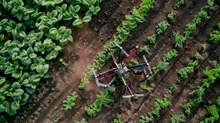
As the climate in many parts of the world becomes hotter and drier, finding new ways to grow food becomes increasingly important. Vertical farming is one popular solution, with farms sprouting up all over the place. The United Arab Emirates, one of the hottest and driest places on the planet, already has several vertical farms, but the largest one opened this week.
At 330,000 square feet—more than three square city blocks—ECO 1 is not only the largest vertical farm in the UAE, but also the largest in the world, according to reports. The facility works in the same way that other vertical farms do, by growing plants without soil or sunlight using LED light and a carefully measured cocktail of nutrients.
Red and blue wavelengths of light interact with chlorophyll to help form glucose and cellulose, the structural material in cell walls, during photosynthesis (which can now be artificially recreated). LEDs can replicate this effect and do so faster than the sun because they filter out elements of sunlight that plants do not use efficiently, such as heat.
The Dubai facility will grow lettuces, arugula, mixed salad greens, and spinach and has the capacity to produce over two million pounds of leafy greens per year.
ECO stands for Emirates Crop One; the vertical farm is a collaboration between Crop One Holdings (a vertical farming company based in Massachusetts) and Emirates Flight Catering (the catering business that serves Emirates Airlines). Greens grown in the vertical farm will be served on Emirates flights and sold in UAE grocery stores. The greens are ready-to-eat and do not need to be washed because they are grown in a sterile environment without pesticides, herbicides, or chemicals.
In many ways, the UAE is an ideal location for vertical farming, if not a place where the technology will soon become indispensable. It receives a lot of sunlight but doesn't have much water (it was, appropriately, the field testing site for a nanoparticle technology that helps sandy soil retain water and nutrients); this means vertical farms could use energy from solar panels to grow food indoors while using 95 percent less water than traditional agriculture.
The location of ECO 1 just outside of Dubai follows the trend of most vertical farms being near major cities. As the world's population continues to grow and urbanize, an increasing number of people will buy all of their food in stores rather than growing any of it on farms or in gardens.
Agricultural yields must therefore increase significantly, and because much of the world's farmable land is already farmed, we have our work cut out for us in terms of becoming more resourceful with our food supply. ECO 1 opened this week, and while it's currently the largest vertical farm in the world, it won't be long before it's surpassed by another; these things just keep growing.












